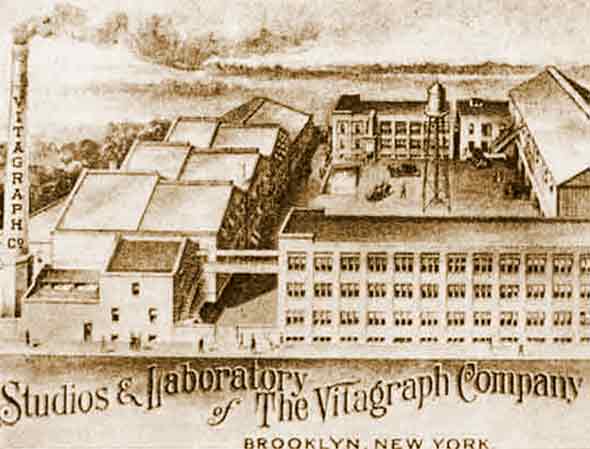
Vitagraph 4 continued from page 3

The Flatbush Studio c. 1910. The water tank stand-in for the Delaware River in Washington Under the American Flag, and for the Red Sea in The Life of Moses, is in the upper left side of the quadrangle. (from Two Reels and a Crank, by Albert E. Smith.)
As a matter
of fact, Greenfield natives became a part of the game. Props and furniture
were rented from the locals, some of whom also worked as extras. Thus did
the village become "a sort of profane Oberammergau. Boys and girls played
movies instead of mudpies; swains brought the romanceful manners of
Vitagraph screen lovers to the town lanes, and the maidens the hoydenish
airs of Helen Gardner to the village green." The lure of the movie studio
extended beyond the village, all the way to Erasmus Hall High School, a
recent expansion of Erasmus Hall Academy, founded in 1786, with John Jay,
Alexander Hamilton and Aaron Burr among its benefactors. Vitagraph's call
was heard by Norma Talmadge, who joined the company in 1910, aged 13, and
became one of the greatest dramatic stars of the silent
era.
The effect of the Big V's
spacious location was immediately evident in its first production, filmed
in 1905, probably before the first modest studio building was finished.
The record of Vitagraph's films between 1900 and 1905 is lost, but its
first Flatbush release was a radical departure from the nickelodeon shorts
of the earlier date. This was a 1,050 foot one-reeler (about fifteen
minutes running time), a dip into the popular literary world for The
Adventures of Raffles, the Amateur Cracksman, based on the
stories by E. W. Hornung and starring J. Barney Sherry, a charter member
of the stock company of actors formed upon the opening of the Flatbush
facility. Raffles was soon followed by a Sherlock Holmes
adaptation, then a production of Booth Tarkington's Monsieur
Beaucaire. Vitagraph's closest approach to literature in 1906,
however, was The Modern Oliver Twist, or, The Life of a
Pickpocket, but the plunder of literature was shortly to be
renewed in earnest, and elevated, after the guardians of public morality
turned their wrath on the content of moving pictures in the next
year.
The industry fought back by
mounting works on historical and religious subjects, as well as literary
classics, and no other studio fought the good fight with the
relish of the Big V. Its "high
art" films were going to bring time-honored works to life, compressed into about
fifteen minutes; at the same time, they were to be walloping good entertainment.
The Flatbush studio enabled it to fulfill its lofty goals and
raise Vitagraph high above all the other filmmmakers of the time.
©2000 The Composing Stack Inc. All rights
reserved.
urbanography is a service mark of The Composing Stack
Inc.
Updated June 25,
2000.